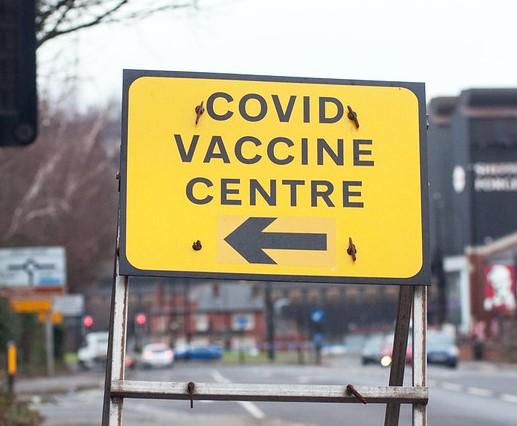New data from clinical trials of the AstraZeneca-Oxford University COVID-19 vaccine suggest it provides strong protection after the first of two doses and could slow the spread of the virus, according to a new preprint study.
The development comes amid a flurry of other vaccine developments today and as health officials look more toward spacing out the two-dose vaccines as a way to protect more people, especially as the threat of more transmissible variants and ones that can escape immunity darken the horizon.
Data affirm UK prime-boost timing
In a preprint in The Lancet, researchers published another month's worth of data and combined findings from four trials that took place in the United Kingdom, South Africa, and Brazil. The new findings follow interim late-stage findings that scientists released in November and a peer-reviewed interim analysis published in early December.
The AstraZeneca-Oxford vaccine uses a weakened common cold virus to carry SARS-CoV-2 genetic material into cells to make coronavirus spike proteins that trigger an immune response. According to the new report, single-dose efficacy was 76% for up to 3 months. With 3 months between the two doses, the interval used in the UK, efficacy was 82.4%. No severe cases or hospitalizations occurred in the 22 days after the first dose.
Also, the team looked at the vaccine's potential to reduce asymptomatic transmission by swabbing volunteers in the UK part of the trial. They found an overall 67% reduction in positive tests after the first vaccine dose, showing a potential for reducing transmission. However, their findings revealed that a single standard dose didn't protect against asymptomatic infection in the first 90 days after vaccination
In December, data from Moderna, presented ahead of US Food and Drug Administration (FDA) emergency use authorization (EUA) review, revealed promising hints that its vaccine may prevent asymptomatic spread, based on testing in people who arrived for their second dose. The new findings for the AstraZeneca-Oxford vaccine bolster evidence that vaccination may help cut transmission.
Andrew Pollard, MBBS, PhD, chief investigator of the Oxford trial, said in a statement from the university that the new findings back up interim data that regulators have used to approve the vaccine for emergency use and supports the UK policy recommendation for a 12-week prime-boost interval. The team also said the findings suggest that the vaccine's efficacy is more influenced by dosing interval than dosing level, a pattern seen with similar vaccine regimens for other diseases, such as Ebola. An earlier study evaluated a halved first dose followed by a standard second dose.
The Oxford team also said they hope to report data on the new variants in the coming days and expect findings to be similar to those reported for other vaccine developers.
GSK forms partnership with CureVac
In other vaccine news, another big pharmaceutical company is teaming with a smaller one to develop COVID-19 vaccines, with an announcement today that London-based GlaxoSmithKline (GSK) is pairing up with Germany-based CureVac to develop both first- and second-generation COVID-19 vaccines.
The companies are currently collaborating on an mRNA vaccine in phase 2b/3 clinical trials. GSK said it is supporting the production of as many as 100 million doses of the first-generation vaccine this year.
The companies also announced a new collaboration, worth $180.5 million, to develop next-generation mRNA vaccines against COVID-19 that would involve multivalent versions to battle multiple emerging variants, with a goal of offering the vaccine in 2022, pending regulatory approval.
COVAX distribution projections unveiled
The World Health Organization (WHO) and its partners today published their first distribution forecast for countries receiving vaccines through COVAX, a program to support vaccine development and ensure equitable access. The WHO's partners include the Coalition for Epidemic Preparedness and Innovations (CEPI) and Gavi, the Vaccine Alliance.
In a statement, the WHO said the forecasts cover early availability of the Pfizer-BioNTech vaccine (1.2 million doses) in the first quarter of this year and with larger volumes of the AstraZeneca-Oxford vaccine in the first half of 2021. It added that the goal of sharing the projections with countries is to enable governments and health systems to plan their national vaccine programs.
The WHO recently announced a COVAX purchase agreement with Pfizer-BioNTech for as many as 40 million doses.
In another COVAX development, China today announced that it would provide 10 million COVID-19 vaccine doses to the program, Xinhua, China's state news agency, reported. The WHO has started to review China's vaccine for an EUA, which once approved, would pave the way for its use in lower-income countries.
In other global headlines:
- Allianz, a financial services firm based in Germany, said today that the slow vaccine rollout in the European Union (EU) could cost the region more than $100 billion in lost economic activity. Vaccination in the EU over the past several weeks has been beset by production and distribution bottlenecks.
- Portugal's health system is on the verge of collapse due to its COVID-19 surge, and medical teams from Germany are on their way to Lisbon to assist, according to Reuters. Germany has also sent hospital beds, and Austria has offered to take some intensive care patients.
- The Pan American Health Organization (PAHO) said today in its weekly briefing that the pandemic in the region has disproportionately affected women, partly because many health workers are women. Officials said cases are decreasing in the United States and Canada but rising in Mexico, Guatemala, Honduras, larger islands in the Caribbean, and nearly every country in South America.
- The global total today topped 104 million cases and is at 104,221,6874 cases, with 2,262,935 deaths, according to the Johns Hopkins online dashboard.


















